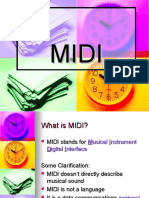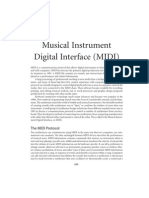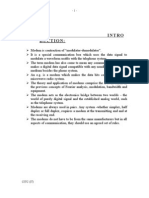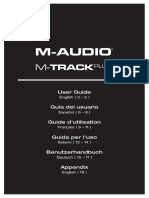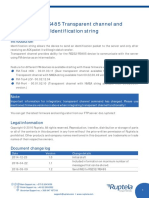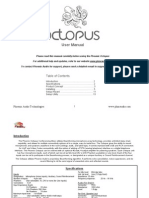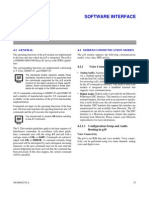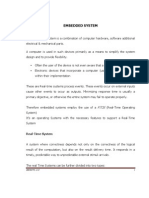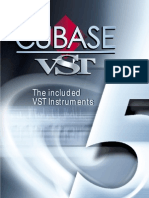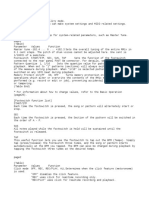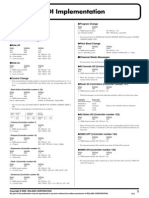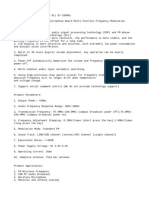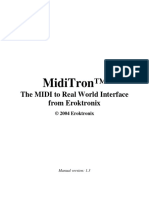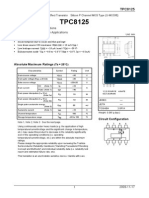Midi Specification
Midi Specification
Uploaded by
NilpimaCopyright:
Available Formats
Midi Specification
Midi Specification
Uploaded by
NilpimaOriginal Description:
Copyright
Available Formats
Share this document
Did you find this document useful?
Is this content inappropriate?
Copyright:
Available Formats
Midi Specification
Midi Specification
Uploaded by
NilpimaCopyright:
Available Formats
MIDI specification
MIDI specification
MIDI: MUSICAL INSTRUMENT DIGITAL INTERFACE
Specification 1.0
INTRODUCTION
MIDI is the acronym for Musical Instrument Digital Interface.
MIDI enables synthesizers, sequencers, home computers, rhythm machines, etc. to be intercon- nected through a
standard interface.
Each MIDI-equipped instrument usually contains a receiver and a transmitter. Some instruments may contain only a
receiver or transmitter. The receiver receives messages in MIDI format and executes MIDI commands. It consists of
an optoisolator, Universal Asynchronous Receiver/Transmitter (UART), and other hardware needed to perform the
intended functions. The transmitter originates messages in MIDI format, and transmits them by way of a UART and
line driver.
The MIDI standard hardware and data format are defined in this specification.
CONVENTIONS
Status and Data bytes given in Tables I through VI are given in binary.
Numbers followed by an "H" are in hexadecimal.
All other numbers are in decimal.
HARDWARE
The interface operates at 31.25 (+/- 1%) Kbaud, asynchronous, with a start bit, 8 data bits (D0 to D7), and a stop bit.
This makes a total of 10 bits for a period of 320 microseconds per serial byte.
Circuit: 5 mA current loop type. Logical 0 is current ON. One output shall drive one and only one input. The receiver
shall be opto-isolated and require less than 5 mA to turn on. Sharp PC-900 and HP 6N138 optoisolators have been
found acceptable. Other high-speed optoisolators may be satisfactory. Rise and fall times should be less than 2
microseconds.
Connectors: DIN 5 pin (180 degree) female panel mount receptacle. An example is the SWITCHCRAFT 57 GB5F.
The connectors shall be labelled "MIDI IN" and "MIDI OUT". Note that pins 1 and 3 are not used, and should be left
unconnected in the receiver and transmitter.
file:///G4/Sites/www-music108-F01/aPages/02/MIDI%20specification.html (1 of 11) [10/17/2001 11:40:43 PM]
MIDI specification
NOTES:
1. Optoisolator is Sharp PC-900. (HP 6N138 or other optoisolator can be used with appropriate changes.)
2. Gates "A" are IC or transistor.
3. Resistors are 5%
Cables shall have a maximum length of fifty feet (15 meters), and shall be terminated on each end by a corresponding
5-pin DIN male plug, such as the SWITCHCRAFT 05GM5M. The cable shall be shielded twisted pair, with the
shield connected to pin 2 at both ends.
A "MIDI THRU" output may be provided if needed, which provides a direct copy of data coming in MIDI IN. For
very long chain lengths (more than three instruments), higher-speed optoisolators must be used to avoid additive
rise/fall time errors which affect pulse width duty cycle.
DATA FORMAT
All MIDI communication is achieved through multi-byte "messages" consisting of one Status byte followed by one or
two Data bytes, except Real-Time and Exclusive messages (see below).
MESSAGE TYPES
Messages are divided into two main categories: Channel and System.
Channel
Channel messages contain a four-bit number in the Status byte which address the message specifically to one
of sixteen channels. These messages are thereby intended for any units in a system whose channel number
matches the channel number encoded into the Status byte.
There are two types of Channel messages: Voice and Mode.
Voice
To control the instrument's voices, Voice messages are sent over the Voice Channels.
Mode
To define the instrument's response to Voice messages, Mode messages are sent over the instument's
Basic Channel.
System
System messages are not encoded with channel numbers.
There are three types of System messages: Common, Real-Time, and Exclusive.
Common
Common messages are intended for all units in a system.
Real-Time
Real-Time messages are intended for all units in a system. They contain Status bytes only -- no Data
bytes. Real-Time messages may be sent at any time -- even between bytes of a message which has a
file:///G4/Sites/www-music108-F01/aPages/02/MIDI%20specification.html (2 of 11) [10/17/2001 11:40:43 PM]
MIDI specification
different status. In such cases the Real-Time message is either ignored or acted upon, after which the
receiving process resumes under the previous status.
Exclusive
Exclusive messages can contain any number of Data bytes, and are terminated by an End of Exclusive
(EOX) or any other Status byte. These messages include a Manufacturer's Identification (ID) code. If
the receiver does not recognize the ID code, it should ignore the ensuing data.
So that other users can fully access MIDI instruments, manufacturers should publish the format of data
following their ID code. Only the manufacturer can update the format following their ID.
DATA TYPES
Status Bytes
Status bytes are eight-bit binary numbers in which the Most Significant Bit (MSB) is set (binary 1). Status
bytes serve to identify the message type, that is, the purpose of the Data bytes which follow the Status byte.
Except for Real-Time messages, new Status bytes will always command the receiver to adopt their status, even
if the new Status is received before the last message was completed.
Running Status
For Voice and Mode messages only, when a Status byte is received and processed, the receiver will
remain in that status until a different Status byte is received. Therefore, if the same Status byte would
be repeated, it may (optionally) be omitted so that only the correct number of Data bytes need be sent.
Under Running Status, then, a complete message need only consist of specified Data bytes sent in the
specified order.
The Running Status feature is especially useful for communicating long strings of Note On/Off
messages, where "Note On with Velocity of 0" is used for Note Off. (A separate Note Off Status byte is
also available.)
Running Status will be stopped when any other Status byte intervenes, except that Real-Time messges
will only interrupt the Running Status temporarily.
Unimplemented Status
Any status bytes received for functions which the receiver has not implemented should be ignored, and
subsequent data bytes ignored.
Undefined Status
Undefined Status bytes must not be used. Care should be taken to prevent illegal messages from being
sent during power-up or power-down. If undefined Status bytes are received, they should be ignored, as
should subsequent Data bytes.
Data Bytes
Following the Status byte, there are (except for Real-Time messages) one or two Data bytes which carry the
content of the message. Data bytes are eight-bit binary numbers in which the MSB is reset (binary 0). The
number and range of Data bytes which must follow each Status byte are specified in the tables which follow.
For each Status byte the correct number of Data bytes must always be sent. Inside the receiver, action on the
message should wait until all Data bytes required under the current status are received. Receivers should
ignore Data bytes which have not been properly preceeded by a valid Status byte (with the exception of
"Running Status," above).
file:///G4/Sites/www-music108-F01/aPages/02/MIDI%20specification.html (3 of 11) [10/17/2001 11:40:43 PM]
MIDI specification
CHANNEL MODES
Synthesizers contain sound generation elements called voices. Voice assignment is the algorithmic process of routing
Note On/Off data from the keyboard to the voices so that the musical notes are correctly played with accurate timing.
When MIDI is implemented, the relationship between the sixteen available MIDI channels and the synthesizer's voice
assignment must be defined. Several Mode messages are available for this purpose (see Table III). They are Omni
(On/Off), Poly, and Mono. Poly and Mono are mutually exclusive, i.e., Poly Select disables Mono, and vice versa.
Omni, when on, enables the receiver to receive Voice messages in all voice Channels without discrimination. When
Omni is off, the receiver will accept Voice messages from only the selected Voice Channel(s). Mono, when on,
restricts the assignment of Voices to just one voice per Voice Channel (Monophonic.) When Mono is off (=Poly On),
any number of voices may be allocated by the Receiver's normal voice assignment algorithm (Polyphonic.)
For a receiver assigned to Basic Channel "N," the four possible modes arising from the two Mode messages are:
Mode
Omni
On
Poly
Voice messages are received from all
Voice channels and assigned to voices
polyphonically.
On
Mono
Voice messages are received from all
Voice Channels, and control only one
voice, monophonically.
Off
Poly
Voice messages are received in Voice
channel N only, and are assigned to
voices polyphonically.
Off
Mono
Voice messages are received in Voice
channels N thru N+M-1, and assigned
monophonically to voices 1 thru M,
respectively. The number of voices M
is specified by the third byte of the
Mono Mode Message.
Four modes are applied to transmitters (also assigned to Basic Channel N). Transmitters with no channel selection
capability will normally transmit on Basic Channel 1 (N=0).
Mode
Omni
On
Poly
All voice messages are transmitted
in Channel N.
On
Mono
Voice messages for one voice are sent
file:///G4/Sites/www-music108-F01/aPages/02/MIDI%20specification.html (4 of 11) [10/17/2001 11:40:44 PM]
MIDI specification
in Channel N.
3
Off
Poly
Voice messages for all voices are
sent in Channel N.
Off
Mono
Voice messages for voices 1 thru M
are transmitted in Voice Channels N
thru N+M-1, respectively. (Single
voice per channel).
A MIDI receiver or transmitter can operate under one and only one mode at a time. Usually the receiver and
transmitter will be in the same mode. If a mode cannot be honored by the receiver, it may ignore the message (and
any subsequent data bytes), or it may switch to an alternate mode (usually Mode 1, Omni On/Poly).
Mode messages will be recognized by a receiver only when sent in the Basic Channel to which the receiver has been
assigned, regardless of the current mode. Voice messages may be received in the Basic Channel and in other channels
(which are all called Voice Channels), which are related specifically to the Basic channel by the rules above,
depending on which mode has been selected.
A MIDI receiver may be assigned to one or more Basic Channels by default or by user control. For example, an eightvoice synthesizer might be assigned to Basic Channel 1 on power-up. The user could then switch the instrument to be
configured as two four-voice synthesizers, each assigned to its own Basic Channel. Separate Mode messages would
then be sent to each four-voice synthesizer, just as if they were physically separate instruments.
POWER-UP DEFAULT CONDITIONS
On power-up all instruments should default to Mode #1. Except for Note On/Off Status, all Voice messages should be
disabled. Spurious or undefined transmissions must be suppressed.
TABLE I
SUMMARY OF STATUS BYTES
STATUS
D7---D0
# OF DATA
BYTES
DESCRIPTION
Channel Voice Messages:
1000nnnn
1001nnnn
1010nnnn
1011nnnn
1100nnnn
2
2
2
2
1
Note Off event
Note On event (velocity=0: Note Off)
Polyphonic key pressure/after touch
Control change
Program change
file:///G4/Sites/www-music108-F01/aPages/02/MIDI%20specification.html (5 of 11) [10/17/2001 11:40:44 PM]
MIDI specification
1101nnnn
1110nnnn
1
2
Channel pressure/after touch
Pitch bend change
Channel Mode Messages:
1011nnnn
Selects Channel Mode
System Messages:
11110000
11110sss
11111ttt
*****
0 to 2
0
System Exclusive
System Common
System Real Time
NOTES:
1. nnnn: N-1, where N = Channel #, i.e. 0000 is Channel 1, 0001 is Channel 2 ... 1111 is Channel 16.
2. *****: 0iiiiiii, data, ..., EOX;
iiiiiii:
Identification
3. sss: 1 to 7
4. ttt: 0 to 7
TABLE II
CHANNEL VOICE MESSAGES
STATUS
1000nnnn
DATA BYTES
0kkkkkkk 0vvvvvvv
1001nnnn
0kkkkkkk 0vvvvvvv
1010nnnn
0kkkkkkk 0vvvvvvv
1011nnnn
0ccccccc 0vvvvvvv
1100nnnn
0ppppppp
1101nnnn
0vvvvvvv
DESCRIPTION
Note Off (see notes 1-4),
vvvvvvv: note off velocity
Note On (see notes 1-4),
vvvvvvv - 0: velocity,
vvvvvvv = 0: note off
Polyphonic Key Pressure (After-Touch),
vvvvvvv: pressure value
Control Change,
ccccccc: control # (0-121) (see notes 5-8),
vvvvvvv: control value,
ccccccc = 122 thru 127: Reserved, (See Table III)
Program Change,
ppppppp: program number (0-127)
Channel Pressure (After-Touch)
vvvvvvv: pressure value
file:///G4/Sites/www-music108-F01/aPages/02/MIDI%20specification.html (6 of 11) [10/17/2001 11:40:44 PM]
MIDI specification
1110nnnn
0vvvvvvv
0vvvvvvv
Pitch Bend Change LSB (see note 10)
Pitch Bend Change MSB
NOTES:
1. nnnn: Voice Channel # (1-16, coded as defined in Table I notes)
2. kkkkkkk: note # (0 - 127)
kkkkkkk = 60: Middle C of keyboard
3. vvvvvvv: key velocity
A logarithmic scale would be advisable.
0
off
1
ppp
pp
mp
mf
64
f
ff
127
fff
vvvvvvv = 64: in case of no velocity sensors
vvvvvvv = 0: Note Off, with velocity = 64
4. Any Note On message sent should be balanced by sending a Note Off message for that note in that channel at
some later time.
5. ccccccc: control number
ccccccc
0
1
2
3
4-31
32
33
34
35
36-63
64-95
96-121
122-127
Description
Continuous Controller 0 MSB
Continuous Controller 1 MSB (MODULATION BENDER)
Continuous Controller 2 MSB
Continuous Controller 3 MSB
Continuous Controllers 4-31 MSB
Continuous Controller 0 LSB
Continuous Controller 1 LSB (MODULATION BENDER)
Continuous Controller 2 LSB
Continuous Controller 3 LSB
Continuous Controllers 4-31 LSB
Switches (On/Off)
Undefined
Reserved for Channel Mode messages (see Table III).
6. All controllers are specifically defined by agreement of the MIDI Manufacturers Association (MMA) and the
Japan MIDI Standards Committee (JMSC). Manufacturers can request throught the MMA or JMSC that
logical controllers be assigned to physical ones as necessary. The controller allocation table must be provided
in the user's operation manual.
7. Continuous controllers are divided into Most Significant and Least Significant Bytes. If only seven bits of
resolution are needed for any particular controllers, only the MSB is sent. It is not necessary to send the LSB.
If more resolution is needed, then both are sent, first the MSB, then the LSB. If only the LSB has changed in
value, the LSB may be sent without re-sending the MSB.
8. vvvvvvv: control value (MSB)
for controllers
0: min
127: max
for switches
file:///G4/Sites/www-music108-F01/aPages/02/MIDI%20specification.html (7 of 11) [10/17/2001 11:40:44 PM]
MIDI specification
0: off
127: on
Numbers 1 through 126, inclusive, are ignored.
9. Any messages (e.g. Note On), which are sent successively under the same status, can be sent without a Status
byte until a different Status byte is needed.
10. Sensitivity of the pitch bender is selected in the receiver. Center position value (no pitch change) is 2000H,
which would be transmitted EnH-00H-40H.
TABLE III
CHANNEL MODE MESSAGES>
STATUS
1011nnnn
DATA BYTES
0ccccccc 0vvvvvvv
DESCRIPTION
Mode Messages
ccccccc = 122: Local Control
vvvvvvv = 0,
Local Control Off
vvvvvvv = 127, Local Control On
ccccccc = 123: All Notes Off
vvvvvvv = 0
ccccccc = 124: Omni Mode Off (All Notes Off)
vvvvvvv = 0
ccccccc = 125: Omni Mode On (All Notes Off)
vvvvvvv = 0
ccccccc = 126: Mono Mode On (Poly Mode Off)
(All Notes Off)
vvvvvvv = M, where M is the number of channels.
vvvvvvv = 0, the number of channels equals
the number of voices in the receiver.
ccccccc = 127: Poly Mode On (Mono Mode Off)
vvvvvvv = 0
(All Notes Off)
NOTES:
1. nnnn: Basic Channel # (1-16, coded as defined in Table I)
2. Messages 123 thru 127 function as All Notes Off messages. They will turn off all voices controlled by the
assigned Basic Channel. Except for message 123, All Notes Off, they should not be sent periodically, but only
for a specific purpose. In no case should they be used in lieu of Note Off commands to turn off notes which
have been previously turned on. Therefore any All Notes Off command (123-127) may be ignored by receiver
with no possibility of notes staying on, since any Note On command must have a corresonding specific Note
Off command.
3. Control Change #122, Local Control, is optionally used to interrupt the internal control path between the
file:///G4/Sites/www-music108-F01/aPages/02/MIDI%20specification.html (8 of 11) [10/17/2001 11:40:44 PM]
MIDI specification
keyboard, for example, and the sound-generating circuitry. If 0 (Local Off mesage) is received, the path is
disconnected: the keyboard data goes only to MIDI and the sound-generating circuitry is controlled only by
incoming MIDI data. If a 7FH (Local On message) is received, normal operation is restored.
4. The third byte of "Mono" specifies the number of channels in which Monophonic Voice messages are to be
sent. This number, "M", is a number between 1 and 16. The channel(s) being used, then, will be the current
Basic Channel (=N) thru N+M-1 up to a maximum of 16. If M=0, this is a special case directing the receiver to
assign all its voices, one per channel, from the Basic Channel N through 16.
TABLE IV
SYSTEM COMMON MESSAGES
STATUS
11110001
11110010
11110011
11110100
11110101
11110110
11110111
DATA BYTES
DESCRIPTION
Undefined
0lllllll 0hhhhhhh Song Position Pointer
lllllll: (Least significant)
hhhhhhh: (Most significant)
0sssssss
Song Select
sssssss: Song #
Undefined
Undefined
none
Tune Request
none
EOX: "End of System Exclusive" flag
NOTES:
1. Song Position Pointer: Is an internal register which holds the number of MIDI beats (1 beat = 6 MIDI clocks)
since the start of the song. Normally it is set to 0 when the START switch is pressed, which starts sequence
playback. It then increments with every sixth MIDI clock receipt, until STOP is pressed. If CONTINUE is
pressed, it continues to increment. It can be arbitrarily preset (to a resolution of 1 beat) by the SONG
POSITION POINTER message.
2. Song Select: Specifies which song or sequence is to be played upon receipt of a Start (Real-Time) message.
3. Tune Request: Used with analog synthesizers to request them to tune their oscillators.
4. EOX: Used as a flag to indicate the end of a System Exclusive transmission (see Table VI).
TABLE V
SYSTEM REAL TIME MESSAGES
STATUS
11111000
11111001
DATA BYTES
DESCRIPTION
Timing Clock
Undefined
file:///G4/Sites/www-music108-F01/aPages/02/MIDI%20specification.html (9 of 11) [10/17/2001 11:40:44 PM]
MIDI specification
11111010
11111011
11111100
11111101
11111110
11111111
Start
Continue
Stop
Undefined
Active Sensing
System Reset
NOTES:
1. The System Real Time messages are for synchronizing all of the system in real time.
2. The System Real Time messages can be sent at any time. Any messages which consist of two or more bytes
may be split to insert Real Time messages.
3. Timing clock (F8H)
The system is synchronized with this clock, which is sent at a rate of 24 clocks/quarter note.
4. Start (from the beginning of song) (FAH)
This byte is immediately sent when the PLAY switch on the master (e.g. sequencer or rhythm unit) is pressed.
5. Continue (FBH)
This is sent when the CONTINUE switch is hit. A sequence will continue at the time of the next clock.
6. Stop (FCH)
This byte is immediately sent when the STOP switch is hit. It will stop the sequence.
7. Active Sensing (FEH)
Use of this message is optional, for either receivers or transmitters. This is a "dummy" Status byte that is sent
every 300 ms (max), whenever there is no other activity on MIDI. The receiver will operate normally if it
never receives FEH. Otherwise, if FEH is ever received, the receiver will expect to receive FEH or a
transmission of any type every 300 ms (max). If a period of 300 ms passes with no activity, the receiver will
turn off the voices and return to normal operation.
8. System Reset (FFH)
This message initializes all of the system to the condition of just having turned on power. The system Reset
message should be used sparingly, preferably under manual command only. In particular, it should not be sent
automatically on power up.
TABLE VI
SYSTEM EXCLUSIVE MESSAGES
STATUS
11110000
DATA BYTES
0iiiiiii
.
(0*******)
.
.
(0*******)
.
DESCRIPTION
Bulk dump etc.
iiiiiii:
identification
Any number of bytes may be sent here,
for any purpose, as long as they all
have a zero in the most significant bit.
file:///G4/Sites/www-music108-F01/aPages/02/MIDI%20specification.html (10 of 11) [10/17/2001 11:40:44 PM]
MIDI specification
11110111
EOX: "End of System Exclusive"
NOTES:
1. iiiiiii: identification ID (0-127)
2. All bytes between the System Exclusive Status byte and EOX or the next Status byte must have zeroes in the
MSB.
3. The ID number can be obtained from the MMA or JMSC.
4. In no case should other Status or Data bytes (except Real-Time) be interleaved with System Exclusive,
regardless of whether or not the ID code is recognized.
5. EOX or any other Status byte, except Real-Time, will terminate a System Exclusive message, and should be
sent immediately at its conclusion.
Heini Withagen, www@eeb.ele.tue.nl
file:///G4/Sites/www-music108-F01/aPages/02/MIDI%20specification.html (11 of 11) [10/17/2001 11:40:44 PM]
You might also like
- Salvesen N.ship Motions and Sea.1970.TRANSDocument38 pagesSalvesen N.ship Motions and Sea.1970.TRANSigorgtgomez_2596335100% (3)
- Cat 3412e PDFDocument4 pagesCat 3412e PDFCristina CoceasuNo ratings yet
- MidiDocument57 pagesMiditeletext45100% (2)
- MidiDocument57 pagesMidiKen Love PianoNo ratings yet
- Structure of MIDI MessagesDocument14 pagesStructure of MIDI MessagesSuhas Talanki100% (1)
- Musical Instrument Digital Interface (MIDI)Document13 pagesMusical Instrument Digital Interface (MIDI)hansenbradNo ratings yet
- Musical Instrument Digital Interface (MIDI)Document13 pagesMusical Instrument Digital Interface (MIDI)jackychangeNo ratings yet
- The MIDI Protocol - A "Language" That Lets Synthesizers, Computers and Other Devices Talk To Each OtherDocument19 pagesThe MIDI Protocol - A "Language" That Lets Synthesizers, Computers and Other Devices Talk To Each OtherAnkit VijNo ratings yet
- ModemDocument7 pagesModemsriramNo ratings yet
- Analog Voltage BitDocument9 pagesAnalog Voltage Bitsbongiseni-mhlanga-3353No ratings yet
- One Choice For Adding Sounds To Multimedia Applications Is The Use of Digital Audio SoundfilesDocument18 pagesOne Choice For Adding Sounds To Multimedia Applications Is The Use of Digital Audio Soundfilesg282beta2No ratings yet
- Keytek CTS-2000 - OWNERS MANUAL: IndexDocument26 pagesKeytek CTS-2000 - OWNERS MANUAL: IndexKapiex DubensNo ratings yet
- Figure 1 Structure of Simple ByteDocument8 pagesFigure 1 Structure of Simple ByteHubert Reynaldo Chang EscalanteNo ratings yet
- MC3 ManualDocument16 pagesMC3 ManualDanniel AmorinNo ratings yet
- Data Communication/MIDI: Juan P BelloDocument18 pagesData Communication/MIDI: Juan P BelloGregg RoseNo ratings yet
- Fb01 Editor User ManualDocument11 pagesFb01 Editor User ManuallistentomerijnNo ratings yet
- Udio Ubsystem: Functional DescriptionDocument20 pagesUdio Ubsystem: Functional DescriptionThomas A. EDISSONNo ratings yet
- 08 - Multi-Function Stereo ConsoleDocument10 pages08 - Multi-Function Stereo ConsolejuhivskunjNo ratings yet
- MIDI FilesDocument21 pagesMIDI FilesAnonymous CPQKqCVPP1No ratings yet
- Mtrackikip Kullanim - KlavuzuDocument6 pagesMtrackikip Kullanim - Klavuzujulimsb97No ratings yet
- EN Transparent Channel and Identification StringDocument6 pagesEN Transparent Channel and Identification StringAndrea ToledoNo ratings yet
- Lecture 2 - MIDI BasicsDocument46 pagesLecture 2 - MIDI BasicsAndres F. Saavedra100% (1)
- MIDI Polyphonic Expression: March-12-2018Document20 pagesMIDI Polyphonic Expression: March-12-2018asdNo ratings yet
- Ani-F: Multi-Format ANI EncoderDocument10 pagesAni-F: Multi-Format ANI EncoderTecnica ACNNo ratings yet
- SPDIFDocument9 pagesSPDIFAyman Muhamad AhmedNo ratings yet
- Phoenix MT454 ManualDocument16 pagesPhoenix MT454 Manualpinke01No ratings yet
- PC Interfacing Fourth Level Lecture Three: Serial (RS232) Port InterfaceDocument9 pagesPC Interfacing Fourth Level Lecture Three: Serial (RS232) Port Interfaceأسامة المياحيNo ratings yet
- Epabx TrainerDocument19 pagesEpabx TrainerMadhusudanan78No ratings yet
- At Commands g18Document105 pagesAt Commands g18HoangKhang ToNo ratings yet
- EtherMPX User Manual v3 (Rev1.2)Document21 pagesEtherMPX User Manual v3 (Rev1.2)papaki_grNo ratings yet
- Musical Instrument Digital InterfaceDocument30 pagesMusical Instrument Digital InterfaceMarcoVillaranReyesNo ratings yet
- Yamaha DX7 ManualDocument34 pagesYamaha DX7 Manualx7No ratings yet
- SUCCI-T ManualDocument2 pagesSUCCI-T ManualVesselin KotarovNo ratings yet
- Embedded SystemDocument119 pagesEmbedded SystemVidushi DalelaNo ratings yet
- Cubase 5 VST InstrumentsDocument12 pagesCubase 5 VST InstrumentsStefanos K.No ratings yet
- Access Virus Addendum 20eDocument18 pagesAccess Virus Addendum 20eIfy NebedumNo ratings yet
- 11 UtilityModeDocument5 pages11 UtilityModejayNo ratings yet
- Sh-201 Midi Imple E1Document9 pagesSh-201 Midi Imple E1nillzhillzNo ratings yet
- ControlSpace ESP-88Document6 pagesControlSpace ESP-88stranfirNo ratings yet
- Ali M1535d+ BriefDocument4 pagesAli M1535d+ BriefCharles KozierokNo ratings yet
- KTGranulator ReadMe PDFDocument3 pagesKTGranulator ReadMe PDFJoséNo ratings yet
- ETSI ES 201 235-1: Specification of Dual Tone Multi-Frequency (DTMF) Transmitters and Receivers Part 1: GeneralDocument7 pagesETSI ES 201 235-1: Specification of Dual Tone Multi-Frequency (DTMF) Transmitters and Receivers Part 1: Generalhadiranji4No ratings yet
- CV 12 ORAC ManualDocument8 pagesCV 12 ORAC Manualplayer808No ratings yet
- FM Radio Modul KinaDocument4 pagesFM Radio Modul KinaBH VideoNo ratings yet
- 41 Mobile100 TechnicalDocument107 pages41 Mobile100 TechnicalCauVong JustinNo ratings yet
- TC General and TCIFDocument27 pagesTC General and TCIFDeepayan ChoudhuryNo ratings yet
- Cisco Voice T1, E1, IsDN Configuration and TroubleshootingDocument21 pagesCisco Voice T1, E1, IsDN Configuration and Troubleshootingtimbrown88No ratings yet
- Miditron Midi To Real World InterfaceDocument4 pagesMiditron Midi To Real World InterfaceYashoda SampathNo ratings yet
- Remote Control TheoryDocument1 pageRemote Control TheoryNeerja AroraNo ratings yet
- Miditron ManualDocument22 pagesMiditron ManualJim ShuttsNo ratings yet
- Synthesizer User Manual - 00C (Model QP-FSPLL-0040-01) V1.7Document17 pagesSynthesizer User Manual - 00C (Model QP-FSPLL-0040-01) V1.7Tribu Vaquero JimenezNo ratings yet
- ADE Vas App PPT NewDocument39 pagesADE Vas App PPT NewHarish MahadevanNo ratings yet
- Mobile Controlled ROBOT Using DTMF Technology - Report1Document10 pagesMobile Controlled ROBOT Using DTMF Technology - Report1Mukesh Yadav0% (2)
- DTW Works Master Specification Version 2006: Issued 2006/08/01Document8 pagesDTW Works Master Specification Version 2006: Issued 2006/08/01Srinivas ChalumuriNo ratings yet
- KX-Tes824 Feature GuideDocument271 pagesKX-Tes824 Feature GuideRazvan CorciuNo ratings yet
- Schematic of FIRE ALARM (ESD or ILSD) & VHF Trans Receiver To VHF RADIO UNIT / PA System or PAGE PHONEDocument4 pagesSchematic of FIRE ALARM (ESD or ILSD) & VHF Trans Receiver To VHF RADIO UNIT / PA System or PAGE PHONEgaladrialNo ratings yet
- DFPlayer Mini Manul PDFDocument12 pagesDFPlayer Mini Manul PDFEverCordovaQuispeNo ratings yet
- Resource ManagerDocument28 pagesResource ManagerSamiul Al HossainiNo ratings yet
- Foam BrochureDocument32 pagesFoam BrochureChristian Emmanuel Gallardo Rivera100% (1)
- COE 456 Secure Network Systems: Lecture 2: Risk Management (Part I) : Identifying and Assessing RiskDocument44 pagesCOE 456 Secure Network Systems: Lecture 2: Risk Management (Part I) : Identifying and Assessing Riskdayas1979No ratings yet
- Cold Mix Technology CRRI PDFDocument76 pagesCold Mix Technology CRRI PDFvvt102No ratings yet
- EPP 331 Manufacturing Technology II (Chapter 19)Document43 pagesEPP 331 Manufacturing Technology II (Chapter 19)hanif yooNo ratings yet
- Eurovac High Volume Collector PackageDocument15 pagesEurovac High Volume Collector PackageDaniel AustinNo ratings yet
- RGPV Workshop Application FormDocument2 pagesRGPV Workshop Application FormcivilNo ratings yet
- Newton's Laws Notes PDFDocument40 pagesNewton's Laws Notes PDFapi-222079148No ratings yet
- Talk On Polished Concrete State of The Art From Europe To Asia - 9.3.2024Document2 pagesTalk On Polished Concrete State of The Art From Europe To Asia - 9.3.2024Sj OnNo ratings yet
- SettingsproviderDocument273 pagesSettingsproviderJosé Manuel QuintanillaNo ratings yet
- ASC302-F23-Term ProjectDocument6 pagesASC302-F23-Term Projectfihay73478No ratings yet
- ANMC Question Paper 2020 - Class 7Document7 pagesANMC Question Paper 2020 - Class 7Niranjan Barhate100% (1)
- Chevelle 1973Document15 pagesChevelle 1973Karla García PantiamanteNo ratings yet
- L - 09 - Inclined Plane SurfaceDocument20 pagesL - 09 - Inclined Plane SurfaceAllen PaulNo ratings yet
- 4 Albert Embankment London Se1 7Sr Telephone: 020 7735 7611 Fax: 020 7587 3210Document23 pages4 Albert Embankment London Se1 7Sr Telephone: 020 7735 7611 Fax: 020 7587 3210khoasunpacNo ratings yet
- Schedule I of High Pressure Pipeline NetworkDocument5 pagesSchedule I of High Pressure Pipeline NetworkPranay PatelNo ratings yet
- Android Application (Report)Document68 pagesAndroid Application (Report)Akash Khaitan0% (1)
- Running Basic Calculations in GaussianDocument4 pagesRunning Basic Calculations in GaussianAnonymous lpJkR8No ratings yet
- 8 - Hazards and Hse Matter's Matrix ReportDocument3 pages8 - Hazards and Hse Matter's Matrix ReportSaboor KabierNo ratings yet
- Equnix PostgreSQL Query TuningDocument45 pagesEqunix PostgreSQL Query TuningPutri Herdiyani100% (1)
- Brief Description: Application Note - Industries & MarketDocument2 pagesBrief Description: Application Note - Industries & MarketJose Oliveros ArdilaNo ratings yet
- Bihar CollageDocument48 pagesBihar CollageSuraj SinghNo ratings yet
- CH134R003 PDFDocument67 pagesCH134R003 PDFKids StrolaNo ratings yet
- Neki Novi Tranzistor JBTDocument7 pagesNeki Novi Tranzistor JBTkorisnik2007aNo ratings yet
- Lane WidthDocument5 pagesLane WidthRajesh Khadka100% (1)
- 8D Report....Document4 pages8D Report....developmentNo ratings yet
- Ic-M506 VHF Instruction ManualDocument124 pagesIc-M506 VHF Instruction ManualAhmedNo ratings yet
- GENIEDocument158 pagesGENIESARAMQR100% (1)



